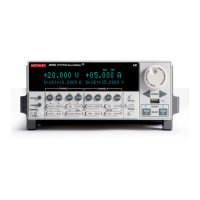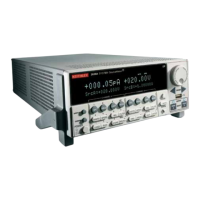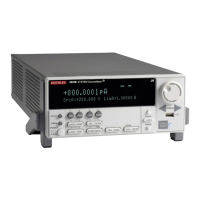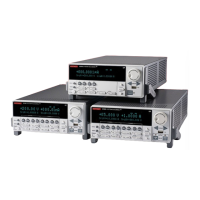3 -7
SECTION 3
Bipolar Transistor Tests
Turn on the computer and start Test Script Builder (TSB). Once 4.
the program has started, open a session by connecting to the
instrument. For details on how to use TSB, see the Series 2600
Reference Manual.
You can simply copy and paste the code from Appendix A in 5.
this guide into the TSB script editing window (Program 6A),
manually enter the code from the appendix, or import the TSP
file ‘DC_Gain_Search.tsp’ after downloading it to your PC.
If your computer is currently connected to the Internet, you
can click on this link to begin downloading: http://www.
keithley.com/data?asset=50925
Install an NPN transistor such as a 2N5089 in the appropriate 6.
transistor socket of the test fixture.
Now, we must send the code to the instrument. The simplest 7.
method is to right-click in the open script window of TSB,
and select ‘Run as TSP file’. This will compile the code and
place it in the volatile run-time memory of the instrument.
To store the program in non-volatile memory, see the “TSP
Programming Fundamentals” section of the Series 2600 Refer-
ence Manual.
Once the code has been placed in the instrument run-time 8.
memory, we can run it at any time simply by calling the func-
tion ‘DC_Gain_Search()’. This can be done by typing the text
‘
DC _ Gain _ Search()
’ after the active prompt in the
Instrument Console line of TSB.
In the program ‘9. DC_Gain_Search.tsp’, the function
DC _
Gain _ Search(vcesource, lowib, highib,
targetic)
is created.
vcesource
• represents the voltage value on the
collector-emitter of the transistor
lowib
• represents the base current low limit for the
search algorithm
highib
• represents the base current high limit for the
search algorithm
targetic
• represents the target collector current for the
search algorithm
If these values are left blank, the function will use the default 10.
values given to the variables, but you can specify each vari-
able value by simply sending a number that is in-range in
the function call. As an example, if you wanted the collector-
emitter voltage (V
CE
) to be 2.5V, the base current low value
at 10nA, the base current high value at 100nA, and the
target collector current to be 10µA, you would send
DC _
Gain _ Search(2.5,10E-9, 100E-9, 10E–6)
to the
instrument.
The sources will be enabled, and the collector current of 11.
the device will be measured. The program will perform an
iterative search to determine the closest match to the target
I
C
(within ±5%). The DC current gain of the device at specific
I
B
and I
C
values will then be displayed on the computer CRT.
If the search is unsuccessful, the program will print “Itera-
tion Level Reached”. This is an error indicating that the search
reached its limit. Recheck the connections, DUT, and variable
values to make sure they are appropriate for the device.
Once the sweep has been completed, the data (I12.
B
, I
C
, and ß)
will be presented in the Instrument Console window of TSB.
3.5.5 Typical Program 6A Results
A typical current gain for a 2N5089 would be about 500. Note,
however, that the current gain of the device could be as low as
300 or as high as 800.
3.5.6 Program 6A Description
Initially, the iteration variables are defined and the instrument is
returned to default conditions. SMUB, which sources I
B
, is set up
as follows:
Source I•
IV compliance, 1.1V range•
Local sense•
SMUA, which sources V
CE
and measures I
C
, is configured as
follows:
Source V•
Local sense•
100mA compliance, autorange measure•
Once the SMU channels have been configured, the sources values
are programmed to 0 and the outputs are enabled. The base cur-
rent (I
B
) is sourced and the program enters into the binary search
algorithm for the target I
C
by varying the V
CE
value, measuring the
I
C
, comparing it to the target I
C
, and adjusting the V
CE
value, if nec-
essary. The iteration counter is incremented each cycle through
the algorithm. If the number of iterations has been exceeded, a
message to that effect is displayed, and the program halts.
Assuming that the number of iterations has not been exceeded,
the DC current gain is calculated and displayed in the Instrument
Console window of the TSB.
3.5.7 Modifying Program 6A
For demonstration purposes, the I
C
target match tolerance is set
to ±5%. You can, of course, change this tolerance as required.
Similarly, the iteration limit is set to 20. Again, this value can be
adjusted for greater or fewer iterations as necessary. Note that it

